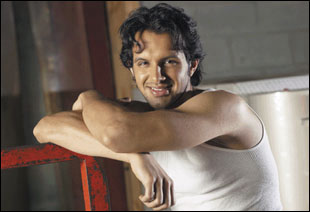Removing Backgrounds
|
| I figured I'd include probably the most-requested masking taskremoving someone from a background while keeping hair detail. We use Extract for this, and even if you've used Extract dozens of times, there's a trick near the end that is so simple, yet so incredibly effective, it will change the way you use Extract forever, or my name isn't Deke McClelland. Step OneOpen the photo containing a person (or an object) that you want to extract from its background. Go under the Filter menu and choose Extract (it's the first filter from the top). 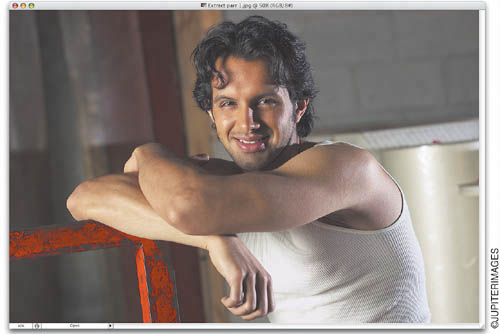 Step TwoThis brings up the Extract dialog. Press B to get the Edge Highlighter tool (it's the top tool in Extract's Toolbox and looks like a marker), and trace the edges of the object you want to remove. As you trace, leave half the marker border on the background and half on the edge of the object you want to extract. 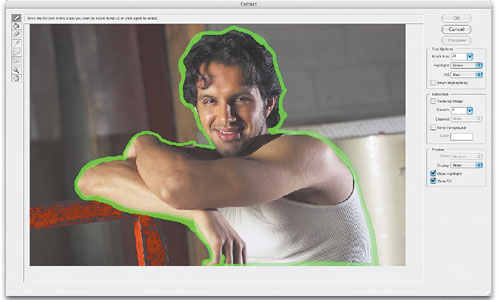 Tip Use a small brush size when tracing areas that are well defined (like along the shirt), and a very large brush for areas that are less defined (such as flyaway hair). You can change the brush size by holding down the Left Bracket key to make it smaller or the Right Bracket to make it larger. Step ThreeAfter your Highlighter edge is in place, you now have to tell Photoshop what parts of the photo to retain when extracting. This is pretty simpleyou just press G to switch to the Fill tool (it's the second tool from the top in Extract's Toolbox and looks like a paint bucket), and click it once inside the Highlighter edge border you drew earlier. This fills the inside of your highlighter border with a blue tint.  Step FourIf the blue tint spills out into the rest of your photo when you click the Fill tool, that means your subject isn't completely enclosed by the edge border. If that happens, just press Command-Z (PC: Control-Z) to undo, then take the Edge Highlighter and make certain there are no gaps at the bottom or sides of your border. Now you can click on the Preview button to see how your extraction looks.  Step FiveIt's time to take a good look at the photo and see if Extract did what you really wanted it to. Namely, did it work on the hair, which is the hard-to-select area? If it worked, then click OK because fixing the rest of the photo is a breeze, as you'll see. Even if parts of his clothes are dropping out, or there are dropouts in his face, hands, etc., don't sweat itas long as the edge of the hair looks good, go ahead and click OK to perform the extraction and your image will appear on an editable layer (Layer 0).  Step SixNow that the extraction is done, it's "fix-up" time. Here, you can see dropouts (slightly transparent areas) in his hair, a few little spots in his shirt, and a couple of little spots in other places. Start by simply duplicating the layer. That's right, just press Command-J (PC: Control-J). The mere act of duplicating the layer will fix about 90% of the dropouts in your photo. It sounds weird, but it works amazingly well, and when you try it, you'll be astounded. Press Command-E (PC: Control-E) to merge these two layers. 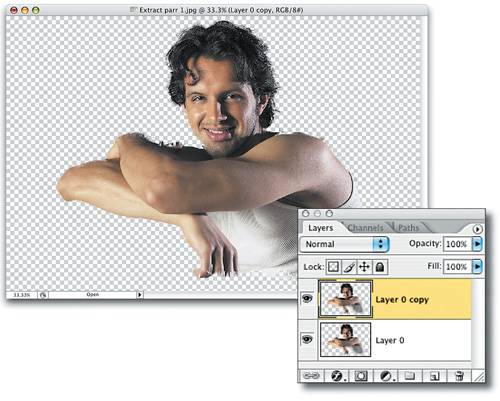 Step SevenFor the rest of the dropouts, press Y to get the History Brush tool and simply paint over these areas. The History Brush will paint those missing pieces back in because it's really an "undo on a brush." So, if part of your subject drops out, use the History Brush to paint it right back in. You can usually fix the dropouts in about two minutes using this technique. Step EightDuring the fix-up stage, I'm painting over dropouts along the man's shoulder. As you see, using the History Brush paints the original image back in. 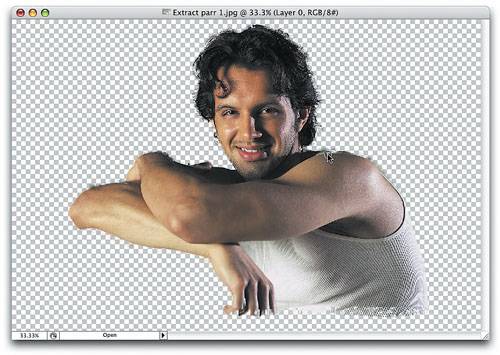 Step NineNext, open the photo that you want to use as a background behind your extracted person. It's best to drag this background photo onto your extracted-person document, because as long as you work in the same document where you extracted, you'll have access to the History Brush for your extracted image. That way, if you see a dropout when you bring in the background, you can return to that layer and quickly touch it up with the History Brush. So press V to switch to the Move tool, and drag-and-drop this photo on top of your extracted image. The background will appear on top of your extracted image on a separate layer (Layer 1) in the Layers palette. 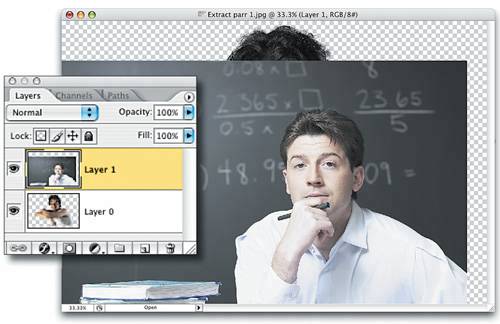 Step TenIn the Layers palette, drag the layer with your background photo (Layer 1) beneath the layer with your extracted photo, putting your extracted person in front of the background (as shown here, where the man in the background photo is partially covered by the extracted man). Using the Move tool, position this background layer until your extracted person appears where you want him. Then, you'll usually have to switch to the Eraser tool (E) to erase any leftover "junk" outside his hair, along his shirt, etc., but you can usually clean up these leftovers pretty easily once you see them over the background. 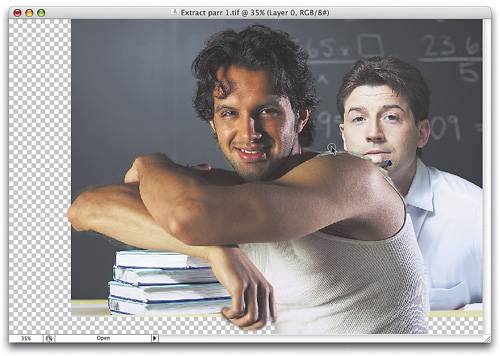 Step ElevenIn this example, because I only want part of the background to appear, I'm stuck with a lot of empty space and unneeded areas. Press the letter C to get the Crop tool, drag a cropping border around the areas you want to keep, and then press Return (PC: Enter) to crop the photo down to size. Now that the photo is cropped, a new problem is visiblehis skin tone looks too warm for the bluish background we've placed him on (and this is something you'll deal with often when combining photosthe tones have to match to look realistic). 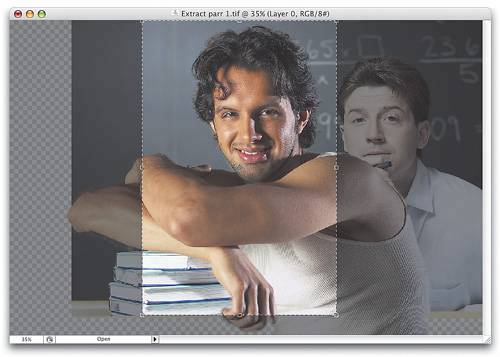 Step TwelveTo cool down his warm skin tones, make sure the top layer is active in the Layers palette, and then go under the Create New Adjustment Layer pop-up menu at the bottom of the Layers palette and choose Photo Filter. These Photo Filters replicate the traditional screw-on lens filters used with film cameras to accommodate bad lighting situations. 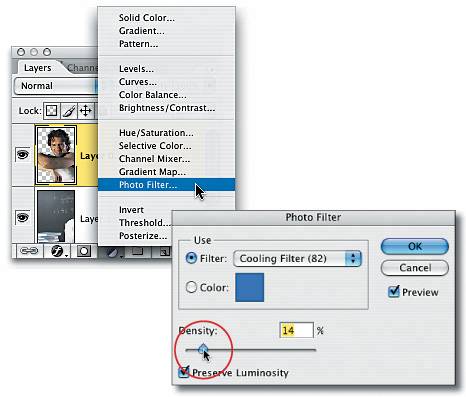 Step ThirteenIn the Photo Filter dialog, you can choose a filter from the Filter pop-up menu (like the Cooling Filter [82] I chose here), or choose to fill with a solid color. You can also control the Density of the effect using the Density slider (I lowered it to 14%). Click OK and the warm areas are cooled, so your subject's flesh tones now better fit the background image you dragged him onto. The original photo The subject extracted, placed onto a different background, re-cropped, and his tone cooled to match the new background. |
|
EAN: N/A
Pages: 187

